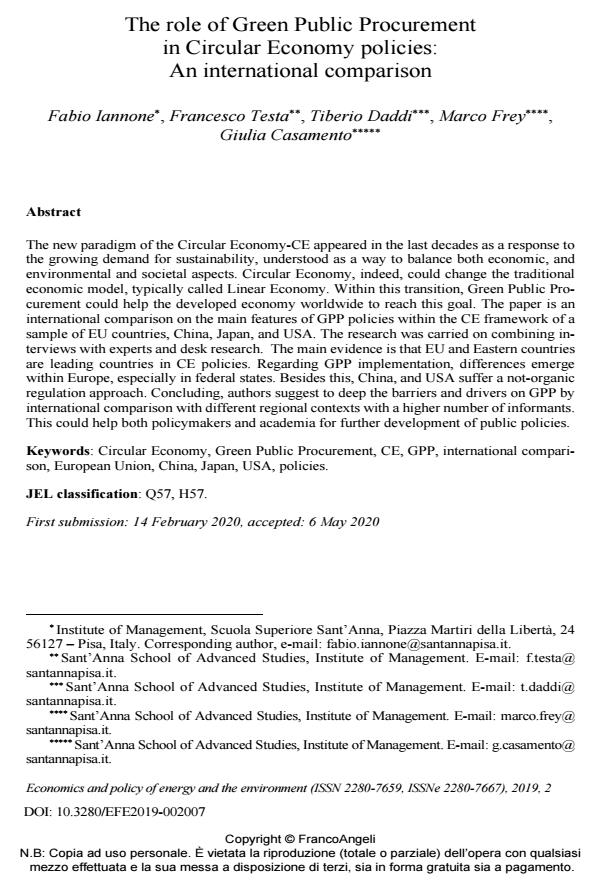The role of Green Public Procurement in Circular Economy policies: An international comparison
Titolo Rivista ECONOMICS AND POLICY OF ENERGY AND THE ENVIRONMENT
Autori/Curatori Fabio Iannone, Francesco Testa, Tiberio Daddi, Marco Frey, Giulia Casamento
Anno di pubblicazione 2020 Fascicolo 2019/2
Lingua Inglese Numero pagine 22 P. 149-170 Dimensione file 158 KB
DOI 10.3280/EFE2019-002007
Il DOI è il codice a barre della proprietà intellettuale: per saperne di più
clicca qui
Qui sotto puoi vedere in anteprima la prima pagina di questo articolo.
Se questo articolo ti interessa, lo puoi acquistare (e scaricare in formato pdf) seguendo le facili indicazioni per acquistare il download credit. Acquista Download Credits per scaricare questo Articolo in formato PDF

FrancoAngeli è membro della Publishers International Linking Association, Inc (PILA)associazione indipendente e non profit per facilitare (attraverso i servizi tecnologici implementati da CrossRef.org) l’accesso degli studiosi ai contenuti digitali nelle pubblicazioni professionali e scientifiche
The new paradigm of the Circular Economy-CE appeared in the last decades as a response to the growing demand for sustainability, understood as a way to balance both economic, and environmental and societal aspects. Circular Economy, indeed, could change the traditional economic model, typically called Linear Economy. Within this transition, Green Public Procurement could help the developed economy worldwide to reach this goal. The paper is an international comparison on the main features of GPP policies within the CE framework of a sample of EU countries, China, Japan, and USA. The research was carried on combining interviews with experts and desk research. The main evidence is that EU and Eastern countries are leading countries in CE policies. Regarding GPP implementation, differences emerge within Europe, especially in federal states. Besides this, China, and USA suffer a not-organic regulation approach. Concluding, authors suggest to deep the barriers and drivers on GPP by international comparison with different regional contexts with a higher number of informants. This could help both policymakers and academia for further development of public policies.
Parole chiave:Circular Economy, Green Public Procurement, CE, GPP, international comparison, European Union, China, Japan, USA, policies
Jel codes:Q57, H57
- Специальный субъект в составах злоупотреблений и подкупа в сфере государственных и муниципальных закупок Shamil Shurpaev, in Law Journal of the Higher School of Economics /2022 pp.51
DOI: 10.17323/2072-8166.2022.4.51.70 - Green public procurement on EU directive 2014/24: adoption effects of mandatory and voluntary transposition Jordi Rosell, in International Environmental Agreements: Politics, Law and Economics /2025
DOI: 10.1007/s10784-025-09696-8 - Zelené verejné obstarávanie: stav poznania Natália Hegedüsová, in Acta Aerarii Publici /2025 pp.73
DOI: 10.24040/aap.2025.22.1.73-91
Fabio Iannone, Francesco Testa, Tiberio Daddi, Marco Frey, Giulia Casamento, The role of Green Public Procurement in Circular Economy policies: An international comparison in "ECONOMICS AND POLICY OF ENERGY AND THE ENVIRONMENT" 2/2019, pp 149-170, DOI: 10.3280/EFE2019-002007